| Revision as of 16:43, 27 March 2020 editMacedonianBoy (talk | contribs)Extended confirmed users9,608 edits →Member states← Previous edit | Revision as of 16:52, 27 March 2020 edit undoMacedonianBoy (talk | contribs)Extended confirmed users9,608 edits →Founding and changes in membershipNext edit → | ||
| Line 9: | Line 9: | ||
| ==Founding and changes in membership== | ==Founding and changes in membership== | ||
| {{main article|Enlargement of NATO}} | {{main article|Enlargement of NATO}} | ||
| NATO has added new members seven times since its founding in 1949, and since 2017 NATO has had 29 members. Twelve countries took part in the founding of NATO: ], ], ], ], ], ], ], ], ], ], ], and ]. In 1952, Greece and Turkey became members of the Alliance, joined later by ] (in 1955) and ] (in 1982). In 1990, with the ], NATO grew to include the former country of ]. Between 1994 and 1997, wider forums for regional cooperation between NATO and its neighbors were set up, including the ], the ] initiative and the ]. In 1997, three former ] countries, ], the ], and ], were invited to join NATO. After this fourth enlargement in 1999, the ] of the Baltics and seven East European countries formed in May 2000 to cooperate and lobby for further NATO membership. Seven of these countries joined in the fifth enlargement in 2004. The ] States ] and ] joined in the sixth enlargement in 2009, ] in 2017. | NATO has added new members seven times since its founding in 1949, and since 2017 NATO has had 29 members. Twelve countries took part in the founding of NATO: ], ], ], ], ], ], ], ], ], ], ], and ]. In 1952, Greece and Turkey became members of the Alliance, joined later by ] (in 1955) and ] (in 1982). In 1990, with the ], NATO grew to include the former country of ]. Between 1994 and 1997, wider forums for regional cooperation between NATO and its neighbors were set up, including the ], the ] initiative and the ]. In 1997, three former ] countries, ], the ], and ], were invited to join NATO. After this fourth enlargement in 1999, the ] of the Baltics and seven East European countries formed in May 2000 to cooperate and lobby for further NATO membership. Seven of these countries joined in the fifth enlargement in 2004. The ] States ] and ] joined in the sixth enlargement in 2009, ] in 2017. The seventh enlargement was ] in March 2020; | ||
| North Macedonia is expected to enter the alliance as the 30th member by the end of March 2020. As of 19 March 2020, Spain was the final member to ratify the accession protocol. | |||
| United States President ] expressed interest in withdrawing from the organization during ], but he later stated that the United States would protect allies in the event that Article V is invoked.<ref>{{Cite news|url=http://www.france24.com/en/20170518-white-house-official-trump-threatens-leave-nato-usa-g7-russia|title=Trump threatens to quit NATO: White House official - France 24|date=2017-05-18|work=France 24|access-date=2017-05-31|language=en-US}}</ref><ref>{{Cite news|url=https://www.nytimes.com/2017/05/25/world/europe/donald-trump-eu-nato.html|title=In NATO Speech, Trump Is Vague About Mutual Defense Pledge|last=Landler|first=Michael D. Shear, Mark|date=2017-05-25|work=The New York Times|access-date=2017-05-31|last2=Kanter|first2=James|language=en-US|issn=0362-4331}}</ref><ref>{{Cite news|url=http://www.latimes.com/politics/la-pol-essential-politics-20170526-story.html|title=A glowing orb and a not-so-glowing review of the GOP healthcare bill: Trump's week was filled with events he didn't control|last=Lauter|first=David|date=2017-05-26|work=Los Angeles Times|access-date=2017-05-31|language=en-US|issn=0458-3035}}</ref> | United States President ] expressed interest in withdrawing from the organization during ], but he later stated that the United States would protect allies in the event that Article V is invoked.<ref>{{Cite news|url=http://www.france24.com/en/20170518-white-house-official-trump-threatens-leave-nato-usa-g7-russia|title=Trump threatens to quit NATO: White House official - France 24|date=2017-05-18|work=France 24|access-date=2017-05-31|language=en-US}}</ref><ref>{{Cite news|url=https://www.nytimes.com/2017/05/25/world/europe/donald-trump-eu-nato.html|title=In NATO Speech, Trump Is Vague About Mutual Defense Pledge|last=Landler|first=Michael D. Shear, Mark|date=2017-05-25|work=The New York Times|access-date=2017-05-31|last2=Kanter|first2=James|language=en-US|issn=0362-4331}}</ref><ref>{{Cite news|url=http://www.latimes.com/politics/la-pol-essential-politics-20170526-story.html|title=A glowing orb and a not-so-glowing review of the GOP healthcare bill: Trump's week was filled with events he didn't control|last=Lauter|first=David|date=2017-05-26|work=Los Angeles Times|access-date=2017-05-31|language=en-US|issn=0458-3035}}</ref> | ||
Revision as of 16:52, 27 March 2020
This article is about the composition of NATO. For historical and future expansion of NATO, see Enlargement of NATO.
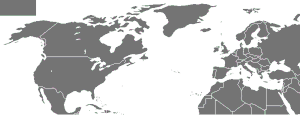
NATO (the North Atlantic Treaty Organization) is an international alliance that consists of 30 member states from North America and Europe. It was established at the signing of the North Atlantic Treaty on 4 April 1949. Article Five of the treaty states that if an armed attack occurs against one of the member states, it shall be considered an attack against all members, and other members shall assist the attacked member, with armed forces if necessary.
Of the 29 member countries, two are located in North America (Canada and the United States), 26 are in Europe, and one is in Europe and Asia (Turkey). All members have militaries, except for Iceland which does not have a typical army (but does, however, have a coast guard and a small unit of civilian specialists for NATO operations). Three of NATO's members are nuclear weapons states: France, the United Kingdom, and the United States. NATO has 12 original founding member nation states, and from 18 February 1952 to 6 May 1955, it added three more member nations, and a fourth on 30 May 1982. After the end of the Cold War, NATO added 13 more member nations (10 former Warsaw Pact members and three former Yugoslav republics) from 12 March 1999 to 5 June 2017.
Founding and changes in membership
Main article: Enlargement of NATONATO has added new members seven times since its founding in 1949, and since 2017 NATO has had 29 members. Twelve countries took part in the founding of NATO: Belgium, Canada, Denmark, France, Iceland, Italy, Luxembourg, the Netherlands, Norway, Portugal, the United Kingdom, and the United States. In 1952, Greece and Turkey became members of the Alliance, joined later by West Germany (in 1955) and Spain (in 1982). In 1990, with the reunification of Germany, NATO grew to include the former country of East Germany. Between 1994 and 1997, wider forums for regional cooperation between NATO and its neighbors were set up, including the Partnership for Peace, the Mediterranean Dialogue initiative and the Euro-Atlantic Partnership Council. In 1997, three former Warsaw Pact countries, Hungary, the Czech Republic, and Poland, were invited to join NATO. After this fourth enlargement in 1999, the Vilnius group of the Baltics and seven East European countries formed in May 2000 to cooperate and lobby for further NATO membership. Seven of these countries joined in the fifth enlargement in 2004. The Adriatic States Albania and Croatia joined in the sixth enlargement in 2009, Montenegro in 2017. The seventh enlargement was N. Macedonia in March 2020;
United States President Donald Trump expressed interest in withdrawing from the organization during his 2016 presidential campaign, but he later stated that the United States would protect allies in the event that Article V is invoked.
Member states
| * | = Member of the EU |
| Flag | Map | English common and formal names |
Domestic common and formal names |
Capital |
Date of accession | Population |
Area |
Notes | |
|---|---|---|---|---|---|---|---|---|---|
 |
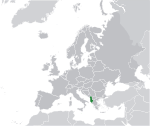 |
Albania Republic of Albania |
Template:Lang-sq | Tirana Template:Lang-sq |
2009-04-01 | 2,887,000 | 28,748 km (11,100 sq mi) | Member of the rival Warsaw Pact 1955–1968. | |
 |
 |
Belgium* Kingdom of Belgium |
Template:Lang-nl Template:Lang-fr Template:Lang-de |
Brussels Template:Lang-nl Template:Lang-fr Template:Lang-de |
1949-08-24 (Founding member) | 11,502,204 | 30,528 km (11,787 sq mi) | ||
 |
 |
Bulgaria* Republic of Bulgaria |
Template:Lang-bg (Bǎlgarija — Republika Bǎlgarija) | Sofia Template:Lang-bg (Sofia) |
2004-03-29 | 7,050,034 | 110,879 km (42,811 sq mi) | Member of the rival Warsaw Pact 1955–1991. | |
 |
 |
Canada | Template:Lang-en Template:Lang-fr |
Ottawa | 1949-08-24 (Founding member) | 37,242,571 | 9,984,670 km (3,855,103 sq mi) | ||
 |
 |
Croatia* Republic of Croatia |
Template:Lang-hr | Zagreb Template:Lang-hr |
2009-04-01 | 4,105,493 | 56,594 km (21,851 sq mi) | Previously part of Yugoslavia 1945–1991 (Non-aligned). | |
 |
 |
Czechia* | Template:Lang-cs | Prague Template:Lang-cs |
1999-03-12 | 10,625,449 | 78,867 km (30,451 sq mi) | Member of the rival Warsaw Pact 1955–1991 as part of Czechoslovakia. | |
 |
 |
Denmark* Kingdom of Denmark |
Template:Lang-da | Copenhagen Template:Lang-da |
1949-08-24 (Founding member) | 5,806,015 | 2,210,000 km (853,286 sq mi) | Denmark's NATO membership includes the Faroe Islands and Greenland. | |
 |
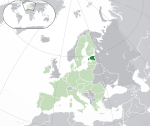 |
Estonia* Republic of Estonia |
Template:Lang-et | Tallinn Template:Lang-et |
2004-03-29 | 1,315,000 | 45,228 km (17,463 sq mi) | Member of the rival Warsaw Pact 1955–1991 as part of the Soviet Union. | |
 |
 |
France* French Republic |
Template:Lang-fr | Paris Template:Lang-fr |
1949-08-24 (Founding member) | 67,348,000 | 643,427 km (248,429 sq mi) | Membership extended as the Fourth French Republic (including French Algeria until 1962). France withdrew from the integrated military command in 1966 to pursue an independent defense system but returned to full participation in 2009. | |
 |
 |
Germany* Federal Republic of Germany |
Template:Lang-de | Berlin Template:Lang-de |
1955-05-8 | 82,800,000 | 357,022 km (137,847 sq mi) | Commonly known as West Germany when it joined; it later reunited with Saarland in 1957 and with the Berlin territories and East Germany on 3 October 1990. East Germany was a member of the rival Warsaw Pact 1956–1990. | |
 |
 |
Greece* Hellenic Republic |
Template:Lang-el (Ellás — Ellinikí Dimokratía) | Athens Template:Lang-el (Athína) |
1952-02-18 | 10,816,286 | 131,957 km (50,949 sq mi) | Membership extended as the Kingdom of Greece. Greece withdrew its forces from NATO's military command structure from 1974 to 1980 as a result of Greco-Turkish tensions following the 1974 Turkish invasion of Cyprus. | |
 |
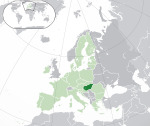 |
Hungary* | Template:Lang-hu | Budapest Template:Lang-hu |
1999-03-12 | 9,771,000 | 93,028 km (35,918 sq mi) | Member of the rival Warsaw Pact 1955–1991. | |
 |
 |
Iceland Republic of Iceland |
Template:Lang-is | Reykjavík Template:Lang-is |
1949-08-24 (Founding member) | 350,710 | 103,000 km (39,769 sq mi) | Iceland, the sole member that does not have its own standing army, joined on the condition that it would not be expected to establish one. However, its strategic geographic position in the Atlantic made it an invaluable member. It has a Coast Guard and has contributed a voluntary peacekeeping force, trained in Norway for NATO. | |
 |
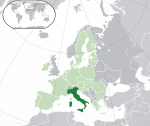 |
Italy* Italian Republic |
Template:Lang-it | Rome Template:Lang-it |
1949-08-24 (Founding member) | 60,494,118 | 301,340 km (116,348 sq mi) | ||
 |
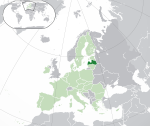 |
Latvia* Republic of Latvia |
Template:Lang-lv | Riga Template:Lang-lv |
2004-03-29 | 1,934,379 | 64,589 km (24,938 sq mi) | Member of the rival Warsaw Pact 1955–1991 as part of the Soviet Union. | |
 |
 |
Lithuania* Republic of Lithuania |
Template:Lang-lt | Vilnius Template:Lang-lt |
2004-03-29 | 2,797,000 | 65,300 km (25,212 sq mi) | Member of the rival Warsaw Pact 1955–1991 as part of the Soviet Union. | |
 |
 |
Luxembourg* Grand Duchy of Luxembourg |
Template:Lang-lb Template:Lang-fr Template:Lang-de |
Luxembourg Template:Lang-lb Template:Lang-fr Template:Lang-de |
1949-08-24 (Founding member) | 602,000 | 2,586 km (998 sq mi) | ||
 |
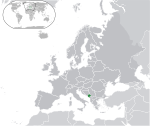 |
Montenegro | Montenegrin: Црна Гора, Crna Gora | Podgorica Montenegrin: Подгорица, Podgorica |
2017-06-05 | 642,550 | 13,812 km (5,333 sq mi) | Previously part of Yugoslavia 1945–1991 (Non-aligned). | |
 |
 |
Netherlands* Kingdom of the Netherlands |
Template:Lang-nl Template:Lang-fy Template:Lang-pap |
Amsterdam (capital) The Hague (seat of government) Template:Lang-nl Template:Lang-fy Template:Lang-pap Template:Lang-nl Template:Lang-fy Template:Lang-pap |
1949-08-24 (Founding member) | 17,272,990 | 41,543 km (16,040 sq mi) | ||
 |
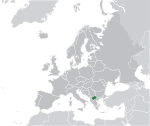 |
North Macedonia | Macedonian: Северна Македонија, Severna Makedonija | Skopje Macedonian: Скопје, Skopje |
2020-03-27 | 2,077,132 | 25,713 km (9,928 sq mi) | Previously part of Yugoslavia 1945–1991 (Non-aligned). | |
 |
 |
Norway Kingdom of Norway |
Template:Lang-nb Template:Lang-nn Template:Lang-se |
Oslo Template:Lang-no |
1949-08-24 (Founding member) | 5,323,933 | 323,802 km (125,021 sq mi) | ||
 |
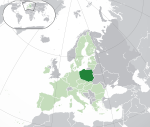 |
Poland* Republic of Poland |
Template:Lang-pl | Warsaw Template:Lang-pl |
1999-03-12 | 38,433,600 | 312,685 km (120,728 sq mi) | Member of the rival Warsaw Pact 1955–1991. | |
 |
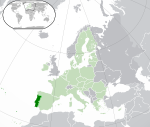 |
Portugal* Portuguese Republic |
Template:Lang-pt | Lisbon Template:Lang-pt |
1949-08-24 (Founding member) | 10,291,196 | 92,090 km (35,556 sq mi) | ||
 |
 |
Romania* | Template:Lang-ro | Bucharest Template:Lang-ro |
2004-03-29 | 19,622,000 | 238,391 km (92,043 sq mi) | Member of the rival Warsaw Pact 1955–1991. | |
 |
 |
Slovakia* Slovak Republic |
Template:Lang-sk | Bratislava Template:Lang-sk |
2004-03-29 | 5,445,087 | 49,035 km (18,933 sq mi) | Member of the rival Warsaw Pact 1955–1991 as part of Czechoslovakia. | |
 |
 |
Slovenia* Republic of Slovenia |
Template:Lang-sl | Ljubljana Template:Lang-sl |
2004-03-29 | 2,070,050 | 20,273 km (7,827 sq mi) | Previously part of Yugoslavia 1945–1991 (Non-aligned). | |
 |
 |
Spain* Kingdom of Spain |
Template:Lang-es | Madrid Template:Lang-es |
1982-05-30 | 47,720,291 | 505,370 km (195,124 sq mi) | ||
 |
 |
Turkey Republic of Turkey |
Template:Lang-tr | Ankara Template:Lang-tr |
1952-02-18 | 80,810,525 | 783,562 km (302,535 sq mi) | ||
 |
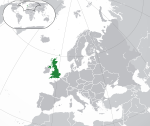 |
United Kingdom United Kingdom of Great Britain and Northern Ireland |
Template:Lang-en Template:Lang-cy |
London | 1949-08-24 (Founding member) | 66,040,229 | 243,610 km (94,058 sq mi) | ||
 |
 |
United States United States of America |
Template:Lang-en | Washington, D.C. | 1949-08-24 (Founding member) | 327,167,434 | 9,833,520 km (3,796,743 sq mi) |
Military personnel
The following list is sourced from the 2018 edition of "The Military Balance" published annually by the International Institute for Strategic Studies.
| Country | Active military | Reserve military | Paramilitary | Total | Per 1000 capita (total) |
Per 1000 capita (active) | |
|---|---|---|---|---|---|---|---|
| 8,000 | 0 | 500 | 8,500 | 2.8 | 2.6 | ||
| 28,800 | 5,000 | 0 | 33,800 | 2.9 | 2.5 | ||
| 31,300 | 3,000 | 0 | 34,300 | 4.8 | 4.4 | ||
| 63,000 | 30,000 | 4,500 | 97,500 | 2.7 | 1.8 | ||
| 15,650 | 0 | 3,000 | 18,650 | 4.3 | 3.6 | ||
| 23,200 | 2,359 | 0 | 25,559 | 2.4 | 2.2 | ||
| 16,100 | 45,700 | 0 | 61,800 | 11 | 2.9 | ||
| 6,600 | 12,000 | 15,800 | 34,400 | 27.5 | 5.3 | ||
| 202,700 | 72,300 | 103,400 | 378,400 | 5.6 | 3 | ||
| 178,600 | 27,900 | 500 | 207,000 | 2.6 | 2.2 | ||
| 141,350 | 220,500 | 4,000 | 365,850 | 34 | 13.1 | ||
| 27,800 | 44,000 | 12,000 | 83,800 | 8.5 | 2.8 | ||
| 200 | 200 | 250 | 650 | 1.9 | 0.6 | ||
| 174,500 | 18,300 | 182,350 | 375,150 | 6 | 2.8 | ||
| 5,310 | 7,850 | 0 | 13,160 | 6.8 | 2.7 | ||
| 18,350 | 6,700 | 11,300 | 36,350 | 12.9 | 6.5 | ||
| 900 | 0 | 600 | 1,500 | 2.5 | 1.5 | ||
| 1,950 | 0 | 10,100 | 12,050 | 18.8 | 3 | ||
| 35,410 | 4,660 | 5,900 | 45,970 | 2.7 | 2.1 | ||
| 23,950 | 38,590 | 0 | 62,540 | 11.8 | 4.5 | ||
| 105,000 | 0 | 73,400 | 178,400 | 4.6 | 2.7 | ||
| 30,500 | 211,950 | 44,000 | 286,450 | 26.4 | 2.8 | ||
| 69,300 | 50,000 | 79,900 | 199,200 | 9.3 | 3.2 | ||
| 15,850 | 0 | 0 | 15,850 | 2.9 | 2.9 | ||
| 7,250 | 1,760 | 5,950 | 14,960 | 7.6 | 3.7 | ||
| 121,200 | 15,450 | 76,750 | 213,400 | 4.4 | 2.5 | ||
| 355,200 | 378,700 | 156,800 | 890,700 | 11 | 4.4 | ||
| 146,650 | 44,250 | 0 | 190,900 | 2.9 | 2.3 | ||
| 1,348,400 | 857,950 | 0 | 2,206,350 | 6.8 | 4.2 |
- The paramilitary forces of Italy consists of the Carabinieri and the Guardia di Finanza.
Military expenditures
The United States has a larger defense expenditure than all other members combined. Criticism of the organization by current US President Donald Trump caused various reactions from American and European political figures, ranging from ridicule to panic. Pew Research Center's 2016 survey among its member states showed that while most countries viewed NATO positively, most NATO members preferred keeping their military spending the same. The response to whether their country should militarily aid another NATO country if it were to get into a serious military conflict with Russia was also mixed. Only in the US and Canada did more than 50% of the people answer that they should.
Table
| Country | Population (2016 est.) |
GDP (nominal) (2018, US$ millions) |
Military expenditures (2019, US$ millions) |
Military expenditures (2019, % of GDP) |
Defence expenditures, (2018, US$ per capita) |
Total military (2017) |
|---|---|---|---|---|---|---|
| 3,038,594 | 15,202 | 198 | 1.26 | 59 | 6,800 | |
| 11,409,077 | 533,153 | 4,921 | 0.93 | 433 | 28,000 | |
| 7,144,653 | 64,963 | 1,079 | 1.61 | 124 | 25,000 | |
| 35,362,905 | 1,711,387 | 21,885 | 1.27 | 641 | 73,000 | |
| 4,313,707 | 60,688 | 1,072 | 1.75 | 269 | 15,000 | |
| 10,644,842 | 242,052 | 2,969 | 1.19 | 260 | 24,000 | |
| 5,593,785 | 350,874 | 4,760 | 1.35 | 758 | 17,000 | |
| 1,258,545 | 30,312 | 669 | 2.13 | 412 | 6,200 | |
| 66,836,154 | 2,775,252 | 50,659 | 1.84 | 788 | 209,000 | |
| 80,722,792 | 4,000,386 | 54,113 | 1.36 | 586 | 180,000 | |
| 10,773,253 | 219,097 | 4,844 | 2.24 | 526 | 106,000 | |
| 9,874,784 | 155,703 | 2,080 | 1.21 | 190 | 19,000 | |
| 335,878 | 25,882 | 4.5 | 14.2 | 0 | ||
| 62,007,540 | 2,072,201 | 24,482 | 1.22 | 406 | 181,000 | |
| 1,965,686 | 34,881 | 724 | 2.01 | 333 | 5,700 | |
| 2,854,235 | 53,323 | 1,084 | 1.98 | 353 | 13,000 | |
| 582,291 | 68,770 | 391 | 0.55 | 579 | 800 | |
| 623,000 | 5,402 | 92 | 1.65 | 128 | 1700 | |
| 17,016,967 | 912,899 | 12,419 | 1.35 | 745 | 41,000 | |
| 5,265,158 | 434,937 | 7,179 | 1.70 | 2,489 | 20,000 | |
| 38,523,261 | 586,015 | 11,971 | 2.01 | 325 | 111,000 | |
| 10,833,816 | 238,510 | 3,358 | 1.41 | 322 | 26,000 | |
| 21,599,736 | 239,851 | 5,043 | 2.04 | 220 | 60,000 | |
| 5,445,802 | 106,585 | 1,905 | 1.74 | 251 | 12,000 | |
| 1,978,029 | 54,242 | 581 | 1.04 | 272 | 6,800 | |
| 48,563,476 | 1,425,865 | 13,156 | 0.92 | 310 | 121,000 | |
| 80,274,604 | 766,428 | 13,919 | 1.89 | 253 | 387,000 | |
| 64,430,428 | 2,828,644 | 60,376 | 2.13 | 924 | 135,510 | |
| 327,465,000 | 20,494,050 | 730,149 | 3.42 | 1,846 | 1,320,000 | |
| 932,645,526 | 36,211,501 | 1,036,077 | 2.51 | 934 | 3,163,000 |
Population data from CIA World Factbook
GDP data from IMF
Expenditure data (except Iceland) from SIPRI Military Expenditure Database, Icelandic data (2013) from Statistics Iceland
Military personnel data from NATO
Iceland has no armed forces.
2015 data.
Notes
- ^ Area and population numbers include integral areas located outside of Europe. The area and population of states with separatist regions includes that of the separatist regions.
- ^ The island of Cyprus is located on the Cyprian arc on the edge of the Anatolian Plate and is physiographically associated with Asia, but it is part of European organisations such as the EU.
- ^ Turkey has territory in both Europe (dark green) and Asia (light green).
- ^ Denmark and the Netherlands are constituent countries of the Kingdom of Denmark and the Kingdom of the Netherlands respectively. Both are members of the EU; however, the other constituent countries of their kingdoms are not. In international organisations, the terms Denmark and the Netherlands are often used as short names for their respective kingdoms as a whole.
- The Netherlands is also known as "Holland", but this name properly refers only to a region of the country. See Netherlands (terminology).
- ^ The United Kingdom (of Great Britain and Northern Ireland) consists of the constituent countries of England, Northern Ireland, Scotland and Wales. The UK is responsible for the foreign relations and ultimate good governance of the Crown dependencies of Guernsey, the Isle of Man and Jersey, which are otherwise separate. England, Scotland and Wales make up the island of Great Britain (or simply Britain), which is sometimes used synonymously with the United Kingdom.
- ^ EU candidate country.
- A simpler official short name has been encouraged by the Czech government. By 2017, this variant remains uncommon. Nevertheless, this term has been adopted by several companies and organisations, including Google Maps, instead of the term "Czech Republic". See Name of the Czech Republic.
References
- Citations
- "The North Atlantic Treaty". North Atlantic Treaty Organization. 4 April 1949. Retrieved 16 June 2008.
- "Trump threatens to quit NATO: White House official - France 24". France 24. 18 May 2017. Retrieved 31 May 2017.
- Landler, Michael D. Shear, Mark; Kanter, James (25 May 2017). "In NATO Speech, Trump Is Vague About Mutual Defense Pledge". The New York Times. ISSN 0362-4331. Retrieved 31 May 2017.
{{cite news}}: CS1 maint: multiple names: authors list (link) - Lauter, David (26 May 2017). "A glowing orb and a not-so-glowing review of the GOP healthcare bill: Trump's week was filled with events he didn't control". Los Angeles Times. ISSN 0458-3035. Retrieved 31 May 2017.
- "Member States". Europa. Retrieved 17 February 2011.
- ^ "Field Listing :: Names". Central Intelligence Agency. Retrieved 30 September 2016.
- ^ "UNGEGN List of Country Names" (PDF). United Nations Statistics Division. 2007. Retrieved 24 February 2011.
- ^ "List of countries, territories and currencies". Europa. 9 August 2011. Retrieved 10 August 2011.
- "Field Listing :: Capital". Central Intelligence Agency. Retrieved 17 February 2011.
- "UNGEGN World Geographical Names". United Nations Group of Experts on Geographical Names. 13 September 2010. Retrieved 24 February 2011.
- "North Atlantic Treaty". United States Department of State. 5 June 2017. Retrieved 1 July 2019.
- "Country Comparison :: Population". Central Intelligence Agency. July 2014. Retrieved 17 October 2014.
- "Field Listing :: Area". Central Intelligence Agency. Retrieved 3 March 2011.
- "Netherlands". Cia.gov. Retrieved 17 February 2011.
- "Turkey's population hits 79.81 million people, increasing over one million". Hürriyet Daily News. Retrieved 1 February 2017.
- IISS 2018, pp. 82
- IISS 2018, pp. 85
- IISS 2018, pp. 88
- IISS 2018, pp. 43
- IISS 2018, pp. 90
- IISS 2018, pp. 94
- IISS 2018, pp. 96
- IISS 2018, pp. 98
- IISS 2018, pp. 102
- IISS 2018, pp. 107-108
- IISS 2018, pp. 111
- IISS 2018, pp. 114
- IISS 2018, p. 116
- IISS 2018, pp. 118
- IISS 2018, pp. 122
- IISS 2018, pp. 124
- IISS 2018, p. 125-126
- IISS 2018, pp. 128
- IISS 2018, pp. 130
- IISS 2018, pp. 132-133
- IISS 2018, pp. 135
- IISS 2018, pp. 138
- IISS 2018, pp. 140
- IISS 2018, pp. 145
- IISS 2018, pp. 147
- IISS 2018, pp. 148
- IISS 2018, pp. 156-157
- IISS 2018, pp. 160-161
- IISS 2018, pp. 46
- Where Does The Relationship Between NATO And The U.S. Go From Here?, Huffington Post
- NATO allies boost defense spending in the wake of Trump criticism, The Washington Post
- Former US ambassador to Nato in withering criticism of Donald Trump, The Independent
- Shaken by Trump’s Criticism of NATO, Europe Mulls Building Own Military Force, Voice Of America
- Support for NATO is widespread among member nations, Pew Research
- U.S. would defend NATO despite Trump's criticism, Europeans believe: study, Reuters
- ^ The Secretary General's Annual Report 2019. NATO. Published in 2018. See pages 108 - 112.
- https://www.nato.int/nato_static_fl2014/assets/pdf/pdf_publications/20190315_sgar2018-en.pdf#page=122
- "World Economic Outlook Database April 2016". International Monetary Fund. International Monetary Fund. April 2015. Retrieved 23 October 2016.
- "SIPRI Military Expenditure Database 2015" (XLS). Stockholm International Peace Research Institute. Stockholm International Peace Research Institute. 2016. Retrieved 23 October 2016.
- "Central government total expenditure by function 1998-2013". Statistics Iceland. Statistics Iceland. 23 September 2014. Retrieved 8 June 2015.
- "Financial and Economic Data Relating to NATO Defence" (PDF). NATO. NATO. 24 February 2014. Retrieved 8 June 2015.
- Bibliography
- International Institute for Strategic Studies (14 February 2018). The Military Balance 2018. London: Routledge. ISBN 9781857439557.
Categories: